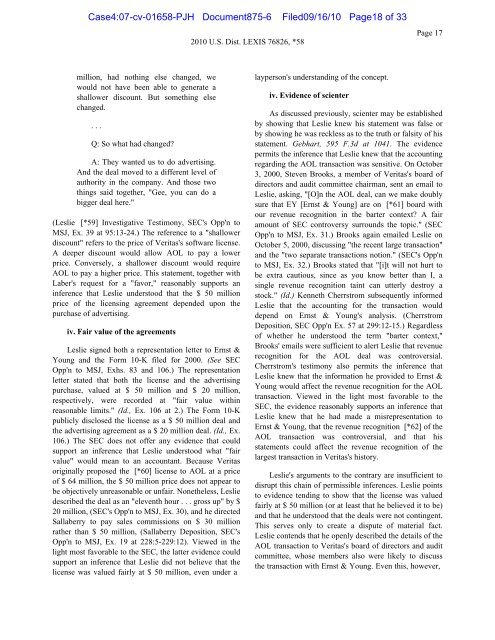exhibit 2 - SAP Lawsuit Portal
exhibit 2 - SAP Lawsuit Portal
exhibit 2 - SAP Lawsuit Portal
Create successful ePaper yourself
Turn your PDF publications into a flip-book with our unique Google optimized e-Paper software.
Case4:07-cv-01658-PJH Document875-6 Filed09/16/10 Page18 of 33<br />
million, had nothing else changed, we<br />
would not have been able to generate a<br />
shallower discount. But something else<br />
changed.<br />
. . .<br />
Q: So what had changed?<br />
A: They wanted us to do advertising.<br />
And the deal moved to a different level of<br />
authority in the company. And those two<br />
things said together, "Gee, you can do a<br />
bigger deal here."<br />
(Leslie [*59] Investigative Testimony, SEC's Opp'n to<br />
MSJ, Ex. 39 at 95:13-24.) The reference to a "shallower<br />
discount" refers to the price of Veritas's software license.<br />
A deeper discount would allow AOL to pay a lower<br />
price. Conversely, a shallower discount would require<br />
AOL to pay a higher price. This statement, together with<br />
Laber's request for a "favor," reasonably supports an<br />
inference that Leslie understood that the $ 50 million<br />
price of the licensing agreement depended upon the<br />
purchase of advertising.<br />
iv. Fair value of the agreements<br />
Leslie signed both a representation letter to Ernst &<br />
Young and the Form 10-K filed for 2000. (See SEC<br />
Opp'n to MSJ, Exhs. 83 and 106.) The representation<br />
letter stated that both the license and the advertising<br />
purchase, valued at $ 50 million and $ 20 million,<br />
respectively, were recorded at "fair value within<br />
reasonable limits." (Id., Ex. 106 at 2.) The Form 10-K<br />
publicly disclosed the license as a $ 50 million deal and<br />
the advertising agreement as a $ 20 million deal. (Id., Ex.<br />
106.) The SEC does not offer any evidence that could<br />
support an inference that Leslie understood what "fair<br />
value" would mean to an accountant. Because Veritas<br />
originally proposed the [*60] license to AOL at a price<br />
of $ 64 million, the $ 50 million price does not appear to<br />
be objectively unreasonable or unfair. Nonetheless, Leslie<br />
described the deal as an "eleventh hour . . . gross up" by $<br />
20 million, (SEC's Opp'n to MSJ, Ex. 30), and he directed<br />
Sallaberry to pay sales commissions on $ 30 million<br />
rather than $ 50 million, (Sallaberry Deposition, SEC's<br />
Opp'n to MSJ, Ex. 19 at 228:5-229:12). Viewed in the<br />
light most favorable to the SEC, the latter evidence could<br />
support an inference that Leslie did not believe that the<br />
license was valued fairly at $ 50 million, even under a<br />
2010 U.S. Dist. LEXIS 76826, *58<br />
layperson's understanding of the concept.<br />
iv. Evidence of scienter<br />
Page 17<br />
As discussed previously, scienter may be established<br />
by showing that Leslie knew his statement was false or<br />
by showing he was reckless as to the truth or falsity of his<br />
statement. Gebhart, 595 F.3d at 1041. The evidence<br />
permits the inference that Leslie knew that the accounting<br />
regarding the AOL transaction was sensitive. On October<br />
3, 2000, Steven Brooks, a member of Veritas's board of<br />
directors and audit committee chairman, sent an email to<br />
Leslie, asking, "[O]n the AOL deal, can we make doubly<br />
sure that EY [Ernst & Young] are on [*61] board with<br />
our revenue recognition in the barter context? A fair<br />
amount of SEC controversy surrounds the topic." (SEC<br />
Opp'n to MSJ, Ex. 31.) Brooks again emailed Leslie on<br />
October 5, 2000, discussing "the recent large transaction"<br />
and the "two separate transactions notion." (SEC's Opp'n<br />
to MSJ, Ex. 32.) Brooks stated that "[i]t will not hurt to<br />
be extra cautious, since as you know better than I, a<br />
single revenue recognition taint can utterly destroy a<br />
stock." (Id.) Kenneth Cherrstrom subsequently informed<br />
Leslie that the accounting for the transaction would<br />
depend on Ernst & Young's analysis. (Cherrstrom<br />
Deposition, SEC Opp'n Ex. 57 at 299:12-15.) Regardless<br />
of whether he understood the term "barter context,"<br />
Brooks' emails were sufficient to alert Leslie that revenue<br />
recognition for the AOL deal was controversial.<br />
Cherrstrom's testimony also permits the inference that<br />
Leslie knew that the information he provided to Ernst &<br />
Young would affect the revenue recognition for the AOL<br />
transaction. Viewed in the light most favorable to the<br />
SEC, the evidence reasonably supports an inference that<br />
Leslie knew that he had made a misrepresentation to<br />
Ernst & Young, that the revenue recognition [*62] of the<br />
AOL transaction was controversial, and that his<br />
statements could affect the revenue recognition of the<br />
largest transaction in Veritas's history.<br />
Leslie's arguments to the contrary are insufficient to<br />
disrupt this chain of permissible inferences. Leslie points<br />
to evidence tending to show that the license was valued<br />
fairly at $ 50 million (or at least that he believed it to be)<br />
and that he understood that the deals were not contingent.<br />
This serves only to create a dispute of material fact.<br />
Leslie contends that he openly described the details of the<br />
AOL transaction to Veritas's board of directors and audit<br />
committee, whose members also were likely to discuss<br />
the transaction with Ernst & Young. Even this, however,


